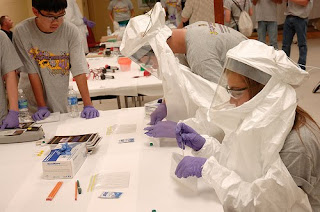Team Advisor Tips: The Scientific Method
Throughout the eCYBERMISSION competition, Team Advisors are provided with helpful tips, worksheets and suggestions for putting together a winning Mission Folder. These tips are intended to be shared with students to help them understand different steps of the scientific method.
This first tip is all about the Scientific Method, the basis of the eCYBERMISSION competition! Registered Team Advisors are also provided with a worksheet for their students. A way for students to practice learning the steps of the scientific method.
What is the Scientific Method?
The scientific method is a process for experimentation that is used to explore observations and answer questions. Scientists use the scientific method to search for cause and effect relationships in nature. The scientific method will help you to focus your Mission Folders, construct a hypothesis, and design, execute and evaluate your experiments.
Steps of the Scientific Method
Ask a Question:
The scientific method begins with questions: How, What, When, Who, Which, Why and Where?
Note – in order for the scientific method to answer the question, it must be something that can be measured.
Background Research:
Use the Internet and supplemental research to learn facts and important information on your topic.
Construct a Hypothesis:
A hypothesis is an educated guess about how things work.
Begin forming a hypothesis by setting it up in the following format:
“If _____ [I do this] ________, then __________ [this] _____ will happen.”
State your hypothesis in a way that can be easily measured and constructed so that it helps you to answer your original question.
Test with an Experiment:
Design an experiment that will help you test your hypothesis. Create an ordered, step-by-step list of everything that must be done to perform the experiment. Think about all the steps that will need to be completed for the experiment, and record exactly what will need to be done in each step.
Analyze Results, Draw Conclusions and Report Results:
Evaluate the data you collected to help you determine if your experiment proved your hypothesis to be true or false. After you determine your results, draw conclusions on why you think your experiment came out the way it did. Think about what parts of your experiment went well, and what things you could have done better.
Team Advisors can register here, to recieve student worksheets and additional tips!
This first tip is all about the Scientific Method, the basis of the eCYBERMISSION competition! Registered Team Advisors are also provided with a worksheet for their students. A way for students to practice learning the steps of the scientific method.
What is the Scientific Method?
The scientific method is a process for experimentation that is used to explore observations and answer questions. Scientists use the scientific method to search for cause and effect relationships in nature. The scientific method will help you to focus your Mission Folders, construct a hypothesis, and design, execute and evaluate your experiments.
Steps of the Scientific Method
Ask a Question:
The scientific method begins with questions: How, What, When, Who, Which, Why and Where?
Note – in order for the scientific method to answer the question, it must be something that can be measured.
Background Research:
Use the Internet and supplemental research to learn facts and important information on your topic.
Construct a Hypothesis:
A hypothesis is an educated guess about how things work.
Begin forming a hypothesis by setting it up in the following format:
“If _____ [I do this] ________, then __________ [this] _____ will happen.”
State your hypothesis in a way that can be easily measured and constructed so that it helps you to answer your original question.
Test with an Experiment:
Design an experiment that will help you test your hypothesis. Create an ordered, step-by-step list of everything that must be done to perform the experiment. Think about all the steps that will need to be completed for the experiment, and record exactly what will need to be done in each step.
Analyze Results, Draw Conclusions and Report Results:
Evaluate the data you collected to help you determine if your experiment proved your hypothesis to be true or false. After you determine your results, draw conclusions on why you think your experiment came out the way it did. Think about what parts of your experiment went well, and what things you could have done better.
Team Advisors can register here, to recieve student worksheets and additional tips!



Comments
Post a Comment
We welcome your comments and expect that our conversation will follow the general rules of respectful civil discourse. This is a moderated blog, and we will only post comments from bloggers over 13 years of age that relate to eCYBERMISSION. We will review comments for posting within one business day. Bloggers are fully responsible for everything that they submit in their comments, and all posted comments are in the public domain. We do not discriminate against any views, but we reserve the right not to post comments.